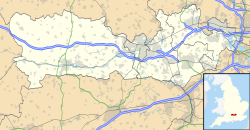| Site of Special Scientific Interest | |
 | |
| Location | Berkshire |
|---|---|
| Grid reference | SU 832 627 [1] |
| Coordinates | 51°21′25″N0°48′25″W / 51.357°N 0.807°W |
| Interest | Biological |
| Area | 6.2 hectares (15 acres) [1] |
| Notification | 1986 [1] |
| Location map | Magic Map |
Wellington College Bog is a 6.2-hectare (15-acre) biological Site of Special Scientific Interest in the grounds of Wellington College on the northern outskirts of Sandhurst in Berkshire. [1] [2]
Contents
The site features a valley bog, [3] which is one of the richest in the county, in terms of bryophytes and flowering plants, containing several species which are uncommon or rare in southern Britain. [3]
